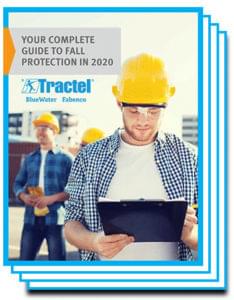Keeping your employees safe on the job is about more than supplying the required fall protection systems. It starts with having an industrial fall protection plan in place before an accident happens. Depending on your worksite, a fall protection plan might be required by OSHA, but they're advisable for any job site where workers are at risk of falling. They bring awareness to safety measures and hazards, keep your business running smoothly, and empower your team to speak up for their own safety and to manage unfortunate incidents if they do occur.
Here are a few items you'll want to include in your industrial fall protection plan. You can also use this worksheet from The Center for Construction Research and Training to help. But before you put your plan in place, let’s take a topline review of what you need to do.
Every job site is different and requires different safety measures. Take a close look at yours to identify all fall hazards. These may include but are not limited to:
You should also identify trip-and-fall hazards, such as clutter or slippery surfaces, and the risk of objects falling and hurting an employee. For example, give attention to materials handling and storage and load requirements.
 When at all possible, you should eliminate a risk by changing your work processes. If that isn't an option, you need to consider what fall protection systems are necessary to mitigate each fall hazard. For example:
When at all possible, you should eliminate a risk by changing your work processes. If that isn't an option, you need to consider what fall protection systems are necessary to mitigate each fall hazard. For example:
Make sure you use OSHA-compliant fall protection systems and other safety equipment. OSHA standard 1910.29 outlines the requirements for guardrails while 1910.140 talks about personal fall protection systems.
Your industrial fall protection plan should outline how to use equipment, how to store it, and how to inspect it for damage.
All employees need to know how to properly use their horizontal lifeline and other fall protection systems. Failure to do so can be more dangerous than not having any equipment at all, since the workers have the confidence of being protected by a system that may fail them because it was improperly installed.
It's also important to properly store safety equipment. Storing unused equipment in a cool, dry place will keep it in working condition for a longer period of time. Still, employees should know how to properly inspect safety equipment before every use. In your plan, explain how employees are to report damaged equipment.
OSHA 1926.1412 outlines guidelines for equipment inspections:
"A competent person must begin a visual inspection prior to each shift the equipment will be used, which must be completed before or during that shift. The inspection must consist of observation for apparent deficiencies.... Determinations made in conducting the inspection must be reassessed in light of observations made during operation."
This includes the inspection of safety equipment as well as machinery. ANSI has requirements, as well:
"According to ANSI/ASSE Z359.2-2007 American National Standards Section 5.5.2 Fall protection equipment shall be inspected by the authorized person at least once at the beginning of each eight hour shift in which it is used to verify that it has not sustained any wear or damage that would require its removal from service."
Your plan needs to explain how and when employees undergo safety training. This is essential for all new employees, and refresher training should be scheduled for employees who have been with you for a long time. Conduct ongoing safety meetings and stay diligent. You might have the best plan and the best equipment, but if you get complacent, those things can start to slide. Continue to assess your workplace for new hazards, and ensure your employees are empowered to report situations where they don't feel safe.
Safety training should include everything in your industrial fall protection plan: how to identify and report hazards, what safety equipment to use and when, how to use/store/inspect safety equipment, and how to handle emergencies.
Despite your best efforts, an accident may happen. Your entire team needs to know how to handle it. This part of the plan outlines that procedure for your job site. You may have slightly different plans for different emergency scenarios within various areas of your workplace.
Call 911 immediately, even if the fall was stopped by a safety harness and horizontal lifeline. It's dangerous for a worker to be suspended for too long, even if he or she appears otherwise unharmed. In some cases, you may be able to rescue the employee yourself, which is why workers need to understand rescue procedures and know how to use rescue equipment. Include CPR and first aid in your training plan so employees are ready to perform it if necessary.
Your industrial fall protection plan is for you and your employees. They should all have access to this written document. And be sure to make updates to it as circumstances change within your workplace. New equipment, new employees, and new procedures are all invitations to assess and update your plan if necessary.
Install all safety equipment as outlined in your plan. Contact us for OSHA-compliant safety guard rails, safety gates, lifelines, and much more.